At the age of 25 and in my first year of motherhood, I’m learning many things. But never in a million years would I have thought helmet therapy would have been one of them.
Honestly, the first thought that came to mind when the doctor recommended an infant helmet for my eight-month-old son, Levi, was that it would be adorable to see him in one.
I had no clue what the experience would be like for Levi. I had so many questions: Would it be uncomfortable? Would it hurt? The worst part was knowing Levi wouldn’t be able to tell me.
While it may seem like a cute accessory, for my family it became an important and necessary piece of medical equipment.
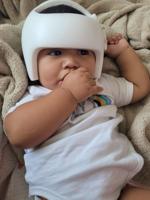
At first the notion of buying my baby a helmet seemed cute, but then it got real and scary.
Several types of head-shape deformities may be managed by a process called orthosis, which is defined by the Oxford Concise Medical Dictionary as “a surgical appliance that exerts external forces on part of the body to support joints or correct deformity.”
We turned to the STAR band from Orthomerica for a custom cranial remolding orthosis. Thousands of infants have been successfully treated with the STAR band, including now my son, Levi. It is used to treat deformational plagiocephaly, brachycephaly, scaphocephaly and other head-shape deformities in infants aged 3 to 18-months.
“Nearly half of U.S. infants develop plagiocephaly, and the incidence has increased since the Back to Sleep campaign was initiated in 1994,” according to healthnews.
In our case, Levi’s helmet was custom-fitted to provide extra space in it. That’s because, as a baby grows in size, their head size grows, too, and the extra space in the helmet accommodates that growth. In addition, the cranial helmet helps to round out a flat spot or asymmetrical area of the baby’s head, which is what my son needed.
First-time helmet therapy moms often struggle to understand what helmet therapy is for and how it works. Although it may seem that the helmet is hurting him or squeezing his head, it is not. It’s actually helping mold your baby’s head shape.
My son, wore his helmet for four months and I wish now that I could go back in time and tell my worried self that the helmet process would not be nearly as bad as I thought. Expensive, potentially. Inconvenient, yes. Dreadful, no.

Baby Levi had to wear his helmet 23 hours a day, getting breaks for bath and cuddle time. Photo by Hernandez.
Here are five things every new mom who suddenly needs to go cranial helmet shopping should know:
They are expensive. If your child is uninsured, or your health insurance refuses to pay for it, a helmet could cost you about $2,000-$3,000. The price varies depending on your provider and your child’s specific case.That amount alone is enough to cause panic, but in our case, Levi’s medical insurance was willing to cover the entire cost.They did make us wait about two months before they would pay up; they wanted to see if his skull would “correct” itself before they invested. In Levi’s case, his flat head did not correct itself. His pediatrician sent us to an orthotist specialist where they provided the helmet for us.
Appointments and more appointments. The most annoying part of Levi’s helmet was the bi-weekly check-up appointments. At his first consultation, orthotist Kirby Miller from the Valley Institute of Prosthetics and Orthotics in Bakersfield put a sock-like over Levi’s head, which he then scanned from his phone to get his measurements. As I expected, Levi did not like the sock over his head. He hates hats. Two weeks later, we returned to the doctor’s office to pick up the helmet. They wanted us to wait a week for the next appointment, but we went in sooner because we kept experiencing problems with the helmet sliding down to his eyes. Two weeks later, we went in again for Dr. Miller to resize one side that was slightly rubbing against Levi’s face, causing redness and a small rash. We have since been told that monthly appointments will continue until the helmet is deemed unnecessary, which means my Levi’s head will almost be perfectly round. Fortunately, because I was working from home during the time, keeping these appointments was not too much trouble. If I were working somewhere else, this appointment schedule would be crazy.
They get sweaty, dirty and stinky – babies and helmets. Right off the bat, we had big concerns, starting with the fact that Levi began wearing his helmet at the start of summer. If you’re from Bakersfield, you know that it’s common for the thermostat to hit the high 90s or 100s. In order for the therapy to work, Levi was required to wear his helmet 23 hours a day. He wears it while he eats, sleeps and plays. His only respite from the helmet is during bath time and when the helmet needs to be cleaned. The result is that by the end of most days, we have one sweaty, dirty, stinky baby and a stinky helmet. Believe me when I tell you that the top of your baby’s head will smell like dirty socks. Fortunately, the fix is a simple one. We bathe Levi twice a day and we clean the helmet daily using a cloth towel, and mixing half water and half alcohol into a little bottle spray. The most time you’ll spend cleaning the helmet is about five minutes.

Hernandez says that cranial helmets get stinky, but are easy to clean with careful maintenance.
The helmets do work. A month into the helmet therapy we started to see progress. His head growth from the back had grown one centimeter. He had to wear it for about four months. We learned that the time frame depends on how fast your little one’s head grows. Being told that your child may have to wear it for months or longer may seem like a lifetime sentence, but time flies. By the time Levi turned one and after consulting with his doctor, Levi’s dad and I decided that it was time to take it off after four full months.The doctor shared with us that after a child turns a year-old, the baby’s head growth is very slow so there wouldn’t be much progress after.
The baby becomes one with the helmet like a Jedi with a lightsaber. My greatest fears upon learning that Levi needed a helmet were that he would hate it, that it would make him uncomfortable and that it would mess up his sleep routine. And that all of those changes would make him upset. When it came right down to it, some of those anxieties did come true. In fact, from the moment we put the helmet on him, he seemed so upset that he started crying right away, which broke my heart. As a parent, it’s very difficult to see your baby in pain. Levi wanted the helmet off but I knew it was for his own good. Even when you are doing everything right you just can’t help to think about where you go wrong. For the first week, I felt horrible. I kept blaming myself for his helmet therapy. I kept telling myself, “What if I didn’t pick him up enough” or “What if I didn’t have enough tummy time?” I had this mom guilt, but what helped me get through it was reading about other mom’s experiences with helmet therapy. For Levi, the five-day initiation schedule certainly helped. For the first five days, he would wear the helmet for an hour or two, then have it off for the following hour. As time went on, he began to wear the helmet for longer stretches of time until, ultimately, he was wearing it all day and all night. It didn’t even affect his sleep. Levis’s orthotist had told me babies don’t mind the helmets, but my baby in fact did.
The last thing a parent wants is for their child to end up with a flat head, especially one that needs to be repaired with a helmet. Even though we tried to keep him off his head and encourage tummy time, the flattening still happened.
Sometimes getting the baby dressed in the morning is a little harder only because his shirt doesn’t fit over his helmet. Sometimes it hurts that you can’t snuggle your little one’s head or cuddle with them because the helmet gets in the way. And of course, cleaning his helmet is definitely an extra step in our daily family routine.
But in the end, new moms like me just adjust just like your baby does. Just know there are tons of babies out there fixing their flat spots, even if their parents aren’t sharing those photos all over their Instagram or Facebook.

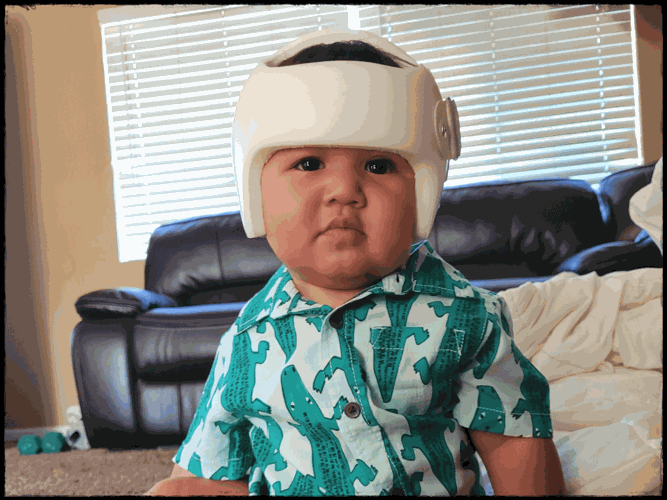


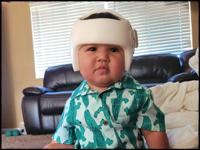

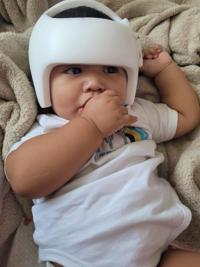

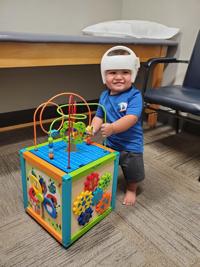


(0) comments
Welcome to the discussion.
Log In
Keep it Clean. Please avoid obscene, vulgar, lewd, racist or sexually-oriented language.
PLEASE TURN OFF YOUR CAPS LOCK.
Don't Threaten. Threats of harming another person will not be tolerated.
Be Truthful. Don't knowingly lie about anyone or anything.
Be Nice. No racism, sexism or any sort of -ism that is degrading to another person.
Be Proactive. Use the 'Report' link on each comment to let us know of abusive posts.
Share with Us. We'd love to hear eyewitness accounts, the history behind an article.